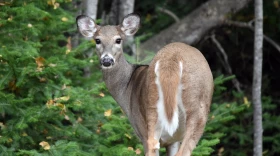So far, this has been an awesome year in Texas for harvesting trophy class whitetail bucks. Today, a buck that makes the Boone and Crockett book with the minimum score of 170 BC has become almost commonplace, especially on well-managed ranches, many of which are high fenced, all across the state.
I, and most veteran deer hunters can remember not too many years ago when there were only a handful of ‘book’ bucks taken in the state each year. While visiting and hunting with my friend outdoor writer and TV show host Larry Weishuhn recently, we spent a good bit of time discussing the subject of the increase of big deer taken in Texas and across the country.
“I think most deer hunters today are educated to the fact that trophy class deer need three things to grow to their potential: genetics, nutrition and age. While all three are important, I truly believe that age and nutrition are the most important. We’ve had some native Texas bucks with massive antlers harvested this year, and without exception, they were fully mature animals that had a highly nutritious diet.” said Weishuhn. “Hunters have learned that it takes a buck at least five or six years to reach their potential for antler development. They’re letting those young bucks walk and reaping the rewards.”
I couldn’t agree more with Larry. When I was a young deer hunter back in the sixties and early seventies, the buzzword among deer hunters is “how many points did he have?” To our way of thinking, a ten point was better than an eight-point, regardless of factors such as age, tine length, mass, etc. Today, experienced deer hunters judge a bucks rack with terms such as mass, tine length, and symmetry rather than strictly number of points. Granted, we all are hunting for a big, mature ten or twelve pointer with a typical frame, rather than a mature 6 or 8 point. Most experienced hunters will let an immature ten point walk and harvest a mature eight-point or even a mature 5 or six point. MATURE is the buzzword today. We have learned that an immature buck that’s been on a good diet has the potential to develop an eight or even ten point rack very early in its life, maybe as a 2.5 year old but, given the time necessary to develop to maturity this same buck might be sporting a high scoring ten or twelve point rack with long, heavy main beams and long tines.
We have also been educated to what a mature buck looks like. Young bucks are slender with smaller necks and shoulders but mature whitetail bucks are much blockier and after the age of 4.5 years, begin to put on a bit of a pot belly.
In the 48 years that I have been hunting whitetails in Texas and, as an outdoors writer, across much of this country and Canada and Mexico, I’ve seen lots of changes. Some I like and some I don’t. Deer hunting is not all about numbers or how many inches of antler a particular buck’s rack sports. On the vast majority of ranches in Texas today, bucks in the 170 BC and bigger are nonexistent. Deer of this size are occasionally harvested from small acreages where deer certainly cross several property lines on a daily basis. But most extremely high scoring bucks are taken from intensively managed ranches, either a high fence or extremely large low fenced ranches, ranches where the majority of the deer never leave the property or..rhe management plan the ranch owner has in place.
To sum it up, deer are hunted for many reasons. Some deer hunters are just out there for the sheer joy of spending a few well earned days at deer camp and are happy for a buck, any buck, and a doe or two for the freezers These guys and gals probably get more enjoyment from all aspects of the hunt than those that are strictly ‘headhunters’.
Others are not willing to release the bowstring or squeeze the rifle’s trigger on anything that scores less than 150 BC. Neither camp is right or wrong, to my way of thinking. Some might be a bit more privileged to have access to intensively managed ranches that others, but I’ve been hunting deer long enough to know that a mature buck is a mature buck. A low scoring, freaky antlered 5-point that might gross 85 BC points can be just as challenging to hunt as one of those high fenced monsters that push 300 inches or antler. May our sport go on forever, regardless whether we consider our ‘trophy’ to be a heavy antlered buck-or venison for the freezer!
My 10-year-old grandson recently harvested a fat 2.5-year-old eight point from a heavily hunted area where most bucks are harvested as soon as they meet legal requirements. Words cannot explain how excited and proud he was to harvest his 8-pointer. Think of it in this perspective: who is the most successful hunter, a kid with his first 8 point buck or a well-heeled sportsman with multiple monster bucks on the wall who just shot another Boone and Crockett buck?
May our sport go on forever, regardless whether we consider our ‘trophy’ to be a heavy antlered buck or, venison for the freezer. I have commented many times that I would continue hunting deer if I knew I could only harvest does and spikes. There’s just something about being out there in the fall with family and friends, pursuing what many consider to be the greatest big game animal of all!








